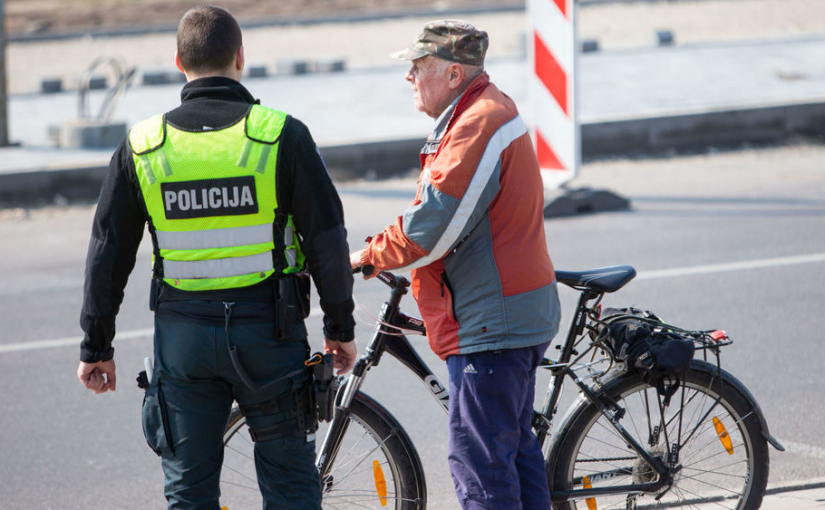The Seimas has drafted a project that will allow cyclists to ride through pedestrian crossings by obliging the cyclist to stop, pass cars and ride through the crossing at pedestrian speeds without endangering pedestrians. During the preparation of the project, an analysis of accident statistics was performed, and good foreign practice was evaluated. According to surveys, almost no one is complying with the current requirement to get off the bike in front of the pedestrian crossing. The new regime is expected to even increase road safety by obliging cyclists to stop and pass cars and pedestrians and to oblige cyclists to drive 3-7 km / h at level crossings for accident prevention. The draft law will be submitted by a group of 14 members of the Seimas. This is with a different composition (wider group) than the working group formed by the Seimas. Main provider Member of the Seimas Dainius Kipnis. Also read: An experienced cyclist has evaluated his city: where is the best place to ride One problem is hindering the use of electric scooters in cities Rinktinės Street – important changes: a new pedestrian and bicycle path will be developed. The project is also based on foreign practice.
On 27 November 2018, the Research Division of the Information and Communication Department of the Seimas conducted an analytical review “Regulation of Bicycle Traffic and Safety Requirements in the Member States of the European Union”. Signatories of the Vienna Convention have studied: Germany, Sweden, United Kingdom, France, Estonia, Latvia. It has been established that the legislation allows cycling through pedestrian crossings in the signatory countries of the Vienna Convention: Germany, Latvia, the United Kingdom, and Estonia. In Germany, for example, road traffic rules do not directly prohibit cyclists from crossing a pedestrian crossing. However, when crossing the carriageway, pedestrians take precedence over motorists, only pedestrians, and cyclists, if they ride, have no preference, and only gain it by getting off and cycling, then they are treated as pedestrians.
In the UK, cycling through pedestrian crossings – Zebras – is for guidance only. In Estonia, cyclists must not endanger pedestrians and choose a safe speed when crossing a pedestrian crossing. In Latvia, cyclists are also allowed to cross the carriageway through pedestrian crossings without impeding pedestrians and reducing speed. Also, Lithuania is a party to the Vienna Convention, so the national legislation adopted by Lithuania cannot contradict it. However, the Vienna Convention does not define cycling at pedestrian crossings at all, leaving it to each signatory to decide what regulation it wants. A petition was submitted to the Seimas, which was approved. It consisted of two parts: the first part proposed the abolition of mandatory reflective vests/lights for cyclists during the day, and the second part proposed changes to the rules for driving through pedestrian crossings. To prepare the project, a survey of 18 institutions (municipalities, police commissariats, courts, prosecutors’ offices) was conducted on cyclists involved in accidents when crossing pedestrian crossings. Her findings: although 90% of cyclists cross the level, according to the petition’s surveys, the accident rate is very low or non-existent. Accident data were obtained from 18 institutions: 16 of those institutions did not find any accidents for the cyclist to cross the crossings; a small accident was recorded in two institutions. For this reason, and due to the disproportionate need for human resources, several authorities have refused to obtain data on road accidents caused by these persons. The Seimas submitted a draft on vests and voted in favor of the submission.
The proposed changes to the rules read as follows: The driver of a bicycle, a motorbike can cross the carriageway on both an adjustable and an unregulated pedestrian crossing when riding a bicycle, motorbike. When approaching an unregulated pedestrian crossing, the driver of a motorcycle must: 1) stop, 2) skip vehicles driving on the carriageway, 3) start driving only when he is convinced that his actions will not force other road users to change direction and speed, 4) start pedestrians pass only convinced that it is safe. When the bicycle is approached by an adjustable pedestrian crossing, the traffic order is set by the traffic bike driver or the regulator. When driving through both an unregulated and an adjustable pedestrian crossing, the cyclist or motorbike driver must ride at a speed close to the speed of the pedestrian (3-7 km / h), give way to pedestrians, not obstruct or endanger them, leaving such a gap from the side to keep traffic safe.
